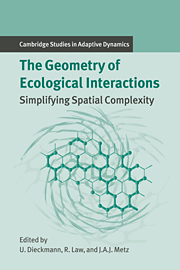Book contents
- Frontmatter
- Contents
- Contributing Authors
- 1 Introduction
- Part A Empirical and Statistical Background: A Plant Ecological Perspective
- Part B When the Mean-field Approximation Breaks Down
- Part C Simplifying Spatial Complexity: Examples
- Introduction to Part C
- 12 Spatial Scales and Low-dimensional Deterministic Dynamics
- 13 Lattice Models and Pair Approximation in Ecology
- 14 Moment Approximations of Individual-based Models
- 15 Evolutionary Dynamics in Spatial Host–Parasite Systems
- 16 Foci, Small and Large: A Specific Class of Biological Invasion
- 17 Wave Patterns in Spatial Games and the Evolution of Cooperation
- Part D Simplifying Spatial Complexity: Techniques
- References
- Index
- International Institute for Applied Systems Analysis
12 - Spatial Scales and Low-dimensional Deterministic Dynamics
Published online by Cambridge University Press: 14 January 2010
- Frontmatter
- Contents
- Contributing Authors
- 1 Introduction
- Part A Empirical and Statistical Background: A Plant Ecological Perspective
- Part B When the Mean-field Approximation Breaks Down
- Part C Simplifying Spatial Complexity: Examples
- Introduction to Part C
- 12 Spatial Scales and Low-dimensional Deterministic Dynamics
- 13 Lattice Models and Pair Approximation in Ecology
- 14 Moment Approximations of Individual-based Models
- 15 Evolutionary Dynamics in Spatial Host–Parasite Systems
- 16 Foci, Small and Large: A Specific Class of Biological Invasion
- 17 Wave Patterns in Spatial Games and the Evolution of Cooperation
- Part D Simplifying Spatial Complexity: Techniques
- References
- Index
- International Institute for Applied Systems Analysis
Summary
Introduction
Biological populations are composed of individuals whose movements are usually limited in space. Consequently, even in a uniform habitat, ecological systems will (and do) show heterogeneity and patchiness at a broad range of temporal and spatial scales. In recent years, ecologists have become increasingly aware of how important an influence spatial heterogeneity has on the dynamics of populations (e.g., Fahrig and Paloheimo 1988; Gilpin and Hanski 1991; McCauley et al. 1993) and persistence of species (e.g., Hastings and Wolin 1989; Reeve 1990; Taylor 1990; Hassell et al. 1991a; Comins et al. 1994; Kareiva and Wennergren 1995). For this reason, there is a strong need to understand and quantify the dynamics and patterns in spatially extended systems.
In this chapter, a number of methodologies or tools for such analyses are introduced. We begin by addressing the question of how to choose the appropriate scale for monitoring a spatial system. Results obtained from both models and field studies are influenced by the scale at which observations and measurements are made (e.g., Sugihara et al. 1990). For many ecological systems, sampling on too small a scale produces data that are noisy and dominated by stochastic effects. Alternatively, sampling on too large a scale averages out the interesting effects. This is because at large scales the dynamics in distant parts of the area sampled are effectively independent. By measuring the temporal variance of the population density as a function of the area sampled, we show that there exists a different scaling behavior above and below the scale at which different parts of the system begin to act independently.
Information
- Type
- Chapter
- Information
- The Geometry of Ecological InteractionsSimplifying Spatial Complexity, pp. 209 - 226Publisher: Cambridge University PressPrint publication year: 2000
Accessibility standard: Unknown
Why this information is here
This section outlines the accessibility features of this content - including support for screen readers, full keyboard navigation and high-contrast display options. This may not be relevant for you.Accessibility Information
- 5
- Cited by
